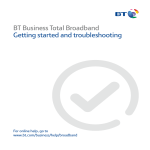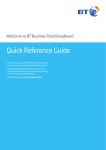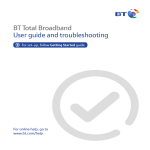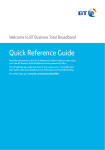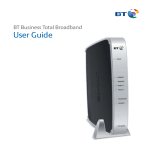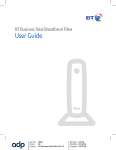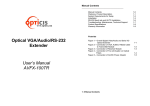Download BT Business Hub 3 User guide
Transcript
BT Infinity for business and fibre User guide and troubleshooting For online help, go to www.bt.com/business/help/broadband Contents Your BT engineer will come and set up your BT Infinity for business or other fibre service and get one computer connected. After this, you’ll find lots more help in this guide, if you need it. Getting up to speed 2 Get some help 4 Connect other computers and devices 6 About your Hub 12 Connection troubleshooting 16 Useful information 22 The small print 24 Contents 1 Getting up to speed For the first 24 hours or so, your broadband might slow down or even stop now and again. That’s normal. It takes that long for your broadband to reach its top speed. You can help it along by leaving your Hub on all the time, and using your broadband as much as you can for the first 24 hours. After ten days, you can check your broadband speed at www.speedtester.bt.com When you use the broadband speed tester: • plug your computer directly into your BT Business Hub with an Ethernet cable – if you use wireless or connect to a Local Area Network (LAN), you won’t get an accurate result • leave your browser open on your computer but close any other tabs or applications • make sure there’s no one else using your network – if there is, you won’t get an accurate result • leave your computer to run the test until it finishes The speed of your broadband line isn’t the only factor that affects how quickly you can work online. There are other things you can do to improve performance: Wireless or wired A wireless connection can be very convenient, but it isn’t the fastest way to connect. Connecting directly to your Hub with an Ethernet cable will be faster and more reliable. If you’re going to connect wirelessly, remember that greater distances and being in different rooms or on different floors will reduce connection speed and reliability. Keep your Hub away from other electrical devices or large metal objects, as these can interfere with the signal. You might also want to consider upgrading your computer to the latest wireless ‘n’ technology for faster wireless speeds – you can now get wireless cards with this at www.businessdirect.bt.com or high street computer shops. 2 Getting up to speed Your computer and the internet The power of your computer can greatly affect performance – if you’ve an older, less powerful processor, you may not be getting the best out of your broadband speed and might want to consider upgrading. Having lots of windows open and lots of users accessing the internet at the same time on the same broadband line can also affect performance. And remember, if lots of people are accessing a web site, the site might not be able to send information to you as fast as you can receive it. Getting up to speed 3 Get some help www.bt.com/business/help/broadband Use these pages to find out where to get lots of help online or if you need some help fixing a connection problem. There’s also connection troubleshooting on page 16. Online help Your new fibre connection means faster help online, if you need it. There’s no need to call and maybe wait in a queue if you’re online and need some help or advice. Simply go to www.bt.com/business/help/broadband Other ways to get help Run BT Broadband Desktop Help – see below. Connecting other computers and devices: go to page 6. Connection troubleshooting: go to page 16. Desktop help – new and better than ever BT Broadband Desktop Help (PCs only) is included with your BT Business broadband service. It’s a tool that identifies problems with your broadband, email or wireless connection and the BT engineer will install it on your computer as part of your installation. It then continually checks your broadband connection. If there’s a problem, BT Broadband Desktop Help automatically pops up to help fix it. To open desktop help, just double-click on your desktop or download it straight to your computer from www.bt.com/business/help/desktopdownload 4 Get some help BT Broadband Desktop Help will: • analyse your computer and equipment • help you fix the problem, step by step • automatically retest your connection BT Broadband Desktop Help gathers information from your computer automatically so, if you need to call the helpdesk, our advisors can diagnose the problem quickly. It doesn’t affect the day-to-day running of your computer, as it works in the background, checking your system and alerting you only if there’s a problem. Note: BT Broadband Desktop Help only works with PCs using Windows 7, Vista or XP. Sorry, it doesn’t work with Macs. If you use a Mac, please try other help options in this guide. Once connected, your new broadband connection means faster help, if you need it. Just go to www.bt.com/business/help/broadband If you still have problems connecting, see page 16. Get some help 5 Connect other computers and devices How to connect other computers or devices using the installation CD Our engineer will have connected your main computer using the installation CD, but if you’d like to connect any other computers or devices, simply run your CD yourself on the computer or device and follow the CD’s set-up wizard. It’s the easiest way to connect other devices. My CD won’t run. What should I do? PC users: click on My Computer in the Windows Start menu, right-click your CD icon, then click BT Business Hub Setup. Mac OS users: double-click the BT Infinity desktop icon, then double-click setup.app. How can I find out if my computer or device works with wireless? Your BT Business Hub 3 is already wireless enabled, so you just need to check that your computer or other device can connect wirelessly. If you’ve bought a laptop in the last couple of years, it’s likely to have wireless built in but you may need to turn it on using a button or switch on your laptop. If you use a normal desktop computer, this may also have wireless built in. If you aren’t sure, check your laptop or desktop computer manual. If your computer doesn’t have wireless built in, you’ll need to fit a wireless adapter. You can get one at www.businessdirect.bt.com or most high street computer shops. Check your computer manual to make sure the type of adapter you plan to buy is compatible with your computer. We recommend that you get an 802.11n compatible wireless adapter; an 802.11b or g wireless adapter will also work, but at lower speeds. To find out more, go to www.bt.com/business/help/hub3wifi 6 Connect other computers and devices How to connect other computers or devices without using the CD If you’ve a wired device Simply plug its Ethernet cable (yellow ends) into one of the spare Ethernet (yellow) ports on the back of your Hub. To get the best speed possible on connections that support 80Mb speeds or over, we recommend you use the GigE socket (port 4). You’ll then need to check your network login details in your Hub Manager (see page 13). If you’ve a wireless device such as laptop, netbook or smartphone Use its wireless feature to connect to your Hub. You’ll need your Hub’s wireless network name and wireless key. You can find these on your Hub’s handy pull-out (see page 12) – there’s a space on page 23 for you to keep a note of these details. Once you’ve found these, follow the instructions that came with your device – for the Hub, read on. If you’re trying to connect a computer or a device, turn on its wireless – there’s usually some sort of switch. Then try hovering your mouse or cursor over the icons in your computer’s system tray or status bar, and look for a wireless icon. If you’re using Windows Vista or XP, you can also try clicking Start then Connect to… . If your computer’s got a wireless connection, find your Hub’s wireless network name in any list displayed (it will start with ‘BTHub3...’), highlight it and click Connect. If you need to, type in your Hub’s wireless key. You’ll then need to check your network login details in your Hub Manager (see page 13). Connect other computers and devices 7 An even easier way to connect devices Your clever new Hub has a WPS (wi-fi protected set-up) button. This means all you need to do to connect a WPS-enabled device or PC (running Windows 7 or Windows Vista with Service Pack 2) is: • use the device or PC you’re trying to connect to broadband • find and highlight your Hub’s network name • click Automatically connect • press the WPS button on your Hub within two minutes To find out more about WPS, go to www.wi-fi.org/wifi-protected-setup You may need these details: Authentication type: WPA2-PSK or WPA-PSK Encryption type: AES (WPA2) or TKIP (WPA) Mode: infrastructure (not ad hoc) 8 Connect other computers and devices What to do if you have a problem connecting your computer to your Hub If the computer’s never been connected to the Hub before, see page 6. Check the Hub lights table and troubleshooting on page 16. If the Broadband light is blue, broadband to your Hub is okay. If your computer can’t connect, these tips may help. 1 If you haven’t already, press the Restart button on your Hub and then try restarting your computer. This often gets connections up and running again. 2 If you’re trying to get to a certain web page, try getting a different web page. The problem may be with the web site you’re trying to get. 3 If you’re using a firewall, check it isn’t blocking your web browser’s connection to the internet. Try temporarily turning off your firewall and then restarting your browser. If you can now get on the internet, there’s a problem with your firewall settings. To fix this problem, see your firewall’s help information. 4 Make sure that the ‘Automatically detect settings’ box is checked in Internet Options/ Connections/LAN settings. Then restart your computer. If your computer’s connected using an Ethernet cable (yellow ends) Check that this cable is plugged in correctly by unplugging and plugging back in each end. Or try plugging the Ethernet cable into one of the other yellow Ethernet sockets on the back of your Hub. If you’re using wireless, many things can affect a wireless connection You could have a problem with interference on your wireless signal, your computer settings or where your computer and Hub are placed. Keep your Hub and computer wireless device away from large metal objects (such as PC cabinets or metal shelving), which restrict the wireless signal and reduce connection speed and reliability. These tips may help. Connect other computers and devices 9 • Check that your computer’s wireless adapter is turned on. Some laptops have a small switch or you might need to turn it on from within your wireless software – please see your computer manual for help • If you’re using a wireless adapter, check it’s correctly installed and connected • Check your wireless connection software – it should show if your computer’s connected to your Hub. Try hovering your mouse or cursor over the icons in your computer’s system tray (usually on the lower right-hand corner of the screen) – one of these may show if your wireless is connected. Click or right-click on this to launch wireless manager If you still can’t get a wireless connection… • Try moving your computer closer to your Hub • Move your computer and Hub away from large electrical appliances • Temporarily turn off other wireless devices, such as wireless TV/video senders or security cameras • If you’ve a desktop PC, check if the wireless adapter is at the back – the signal will be obstructed. To help improve the connection, try putting your PC on (not beneath) your desk or inserting a wireless card in the front of your PC. Even better, consider getting a longer Ethernet cable to plug into your Hub and computer – you can get these from www.businessdirect.bt.com or high street computer shops • If you’ve a laptop with an internal wireless card, consider getting an external adapter with wireless ‘n’ technology. (Some of the latest laptops have wireless ‘n’ technology, but if your laptop’s over a year old it’s likely to have ‘g’ technology, which has a lower speed and range.) Note: if your computer has an Ethernet port, try plugging in the Ethernet cable. This may help you to get online. For more help with fixing connection problems, go to www.bt.com/business/help/hub3 If you still have problems connecting, see page 16. 10 Connect other computers and devices Change wireless channel Your Hub is always monitoring the wireless channel it’s using and if it detects too much interference it will automatically change to another channel. If you want to refresh a channel, follow the steps below. Or you can manually change to a channel of your choice – but this will stop the automatic channel selection feature. 1 Open BT Broadband Desktop Help by double-clicking its icon on your desktop. 2 Click PC Healthcheck. 3 Click the wireless tab. 4 Follow the instructions to change wireless channel. If you can’t use desktop help, you can manually change wireless channels using the steps below. You’ll need a computer connected to the Hub so you can access your Hub Manager. 1 Access Hub Manager by typing http://btbusinesshub.home into the address bar of your web browser. 2 Click Settings. 3 If asked, enter your Hub Admin password. You’ll find this on the bottom of your Hub. 4 In the Basic Settings menu, click Change the wireless channel to avoid interference. 5 Scroll down to the channel selection option and choose a new channel from the drop-down menu. We suggest you try channel 1, 6 or 11 first. 6 Click Apply to confirm the change. Then wait 60 seconds for your computer to find the new settings automatically. (You don’t need to change any settings on your computer.) Connect other computers and devices 11 About your Hub Hub Manager Your BT Business Hub 3 is like a computer. It has its own software running, which controls how it works and what it does. You can change your Hub’s settings using your Hub Manager – simply open your web browser and type http://btbusinesshub.home in the address bar. Access to your Hub Manager is secured using a password. When accessing the Hub Manager for the first time, you’ll be asked to enter the Admin password – see your Hub’s handy pull-out . You will then be asked to enter a new password of your choice. There’s some space on page 23, if you’d like to write it down. You can also enter a password hint that can help you remember your password when you need it. BTHub3-ABCD 1234abcdef 1234ABCD +064422+1234567890 MAC 000111222333444 12345678 Example only If you can’t remember your Admin password, you can use the Password Override feature. When you’re in Hub Manager, press the Password Override button. Then press and hold the WPS button for about 20 seconds and you’ll then need to enter the wireless key (see your Hub’s pull-out) as the username, and the serial number (see under Hub) as the password. You’ll then need to enter a new password as if you were accessing the Hub Manager for the first time. 12 About your Hub Your network login details If you want to set up your Hub without using the CD, or you’ve had to reset your Hub, you’ll need to make sure that your unique network login username and password (sent to you in your ‘welcome’ emails and letters) are entered in your Hub Manager. Open your Hub Manager and click the Broadband User Name Configure button. Make sure this matches the details sent to you in your ‘welcome’ emails and letters. If it doesn’t, click Disconnect, enter the username and password sent to you and click Connect. Hub sockets summary Broadband: ADSL socket (grey) only for connection to broadband ADSL Broadband: BT Infinity connects your Hub to Openreach fibre equipment socket (red) Ethernet sockets (yellow) 1-4 connects computers, servers or other devices using a wired connection (no. 4 is a GigE port, which is used for high-speed devices or servers) USB socket for connecting USB 2.0 memory devices or external hard drives Power socket connects your Hub to mains power using the Hub’s power cable About your Hub 13 Hub features Your Hub offers a wide range of features, many of which aren’t needed for day-to-day use. Power Save mode and Access controls are popular everyday features that you may find useful. BT Power Save Your Hub 3 comes with Power Save, which means it goes into sleep mode if there’s been no activity for over five minutes. All lights will be dimmed and your Hub will wake up as soon as you need it. You can also set a manual Power Save to turn off wireless between preset times of the day. You do this through your Hub Manager (the Power light will then be orange). To find out more about your Hub features, go to www.bt.com/business/help/hub3 Hub wireless details If the BT engineer replaced your old Hub with a new one, he or she may have transferred your old Hub’s wireless settings to your new Hub – there’s space on page 23 for you to keep a note of these details. Static IP If you’ve ordered Static IP addresses, you can find out more about them and how to assign them at www.bt.com/business/help/IPAddresses BT Wi-fi Your new BT Business Hub 3 comes already set up as a BT Wi-fi hotspot, so you can offer your customers wireless access from your premises – and even earn some extra income. To find out how to change the settings or disable the hotspot, go to www.bt.com/business/help/hub3wifi 14 About your Hub Resetting your Hub WARNING: resetting your Hub means you’ll lose any changes that have been made to your Hub software, including any changes made by the BT engineer. Tip: you can back up your settings before you reset your Hub. To find out more, go to www.bt.com/business/help/hub3 To reset your Hub to its factory default settings, removing all personal settings: 1 use a pin or paperclip to press and release the recessed Reset button on the back of your Hub. All Hub lights will go out 2 wait for the Hub’s Broadband light to glow blue – this may take several minutes 3 reset any changes that you or your BT engineer made before in Hub Manager • • • • This may include: resetting your BT Wi-fi hotspot settings resetting any wireless settings that you changed resetting your Hub Admin password and any Hub Manager changes resetting your network login details (see page 13) What to do with an old Hub If you’ve got a new Hub as a replacement for a faulty one, please return the faulty one with its power cable using the returns envelope sent with the replacement. If you don’t have a returns envelope or you’ve other old electrical equipment you’d like to dispose of, please follow your local authority’s recycling advice. Before disposing of any such equipment, we recommend you reset it to its default settings – this should remove all your personal settings. To find out how to reset your Hub to its default settings, see above. We recommend that you keep your old Hub in case you move back to standard broadband. For more help, go to www.bt.com/business/help/hub3 About your Hub 15 POWER Connection troubleshooting POWER PON The first thing to do if your connection isn’t working is check your modem and find out what to do using the table below. You could have either an Openreach modem or an Openreach optical network connector. POWER POWER POWERPON Optical POWER PON POWER POWER POWER light status POWER POWER DSL POWER DSL POWER Off POWER Off POWER DSL DSL DSL DSL DSL DSL Flashing green PORT3 PORT2 PORT1 PORT2 PORT3 PORT1 PORT4 TEL2 TEL1 TEL1 POWER TEL2 POWER Openreach optical network connector light status OpticalPORT1 PON Optical POWERPOWER PON POWER Flashing green POWER POWER DSL DSL DSL PORT4 PON OpticalPORT1 POWER PON OPTICAL Openreach modem POWER LOS Off Not applicable PORT1 PON LOS PON PORT1 Optical PON POWER PON Not applicable PON LOS Optical Optical PON Optical PORT1 PON Optical What’s happening There’s a problem with your power supply or power is off Modem is restarting Broadband isn’t working PON or Optical flashing green Modem is restarting Off Modem can’t detect Hub PON green, LOS is off or Optical is green Modem is connected to broadband and your Hub, and is working PON off, LOS or Optical is red Broadband isn’t working DSL DSL DSL DSL LAN1 DSL LAN1 Off LOS Optical PON PORT1 PON LOS PORT1 Optical PORT1 DSL DSL DSL steady green DSL DSL LAN1 LAN1 LAN1 LAN 1 green Optical PON LOS PON Optical PON LOS PORT1 PON LAN1 DSL LAN1 LAN1 Not applicable PON LOS Optical LOS PON LOS Optical PON LOS LAN1 Still not working? If you’ve tried the table above, call us on the number shown LAN1 LAN1 under ‘Need help?’ in your ‘welcome’ emails and letters. For more help to fix a fault, LAN1 LAN1 go LOS Optical Optical LOS Optical to www.bt.com/business/faults LOSPON Optical 16 Connection troubleshooting LAN1 Optical PON Optical PON LOS What to do Check your power cable’s plugged in correctly and mains power is on. Then restart your modem Wait until light is green – can take a couple of minutes Check the DSL cable is plugged into the DSL socket on the back of the modem and the engineer-installed wall socket. If you’re using an extension socket, check this is also plugged in. Restart your modem Wait until the light is steady green – this can take a few minutes Check your broadband cable is plugged in between the LAN 1 socket on your modem and the red Infinity socket on your Hub. Check your Hub’s Power light is blue – if it isn’t, see page 16. Then try restarting your modem. Then restart your Hub: press and release the Restart button on the side Check Hub lights table on page 16 for connection troubleshooting Check the fibre cable isn’t damaged and is firmly plugged in Connection troubleshooting 17 If you still have trouble connecting, check your Hub lights and find out what to do using the table below. Hub light status What’s happening Power light is off There’s a problem with your power supply Power light briefly solid orange and then flashing orange Hub is restarting Power light is red Hub has a problem restarting Power light is orange BT Power Save is active Power light is blue Hub’s power supply is okay Broadband light is off There isn’t a broadband connection Broadband light flashing orange, then purple/pink and orange Hub’s connecting to broadband Broadband light is orange Hub can’t connect to broadband 18 Connection troubleshooting What to do Check your power cable’s plugged in correctly and mains power is on. Note: check your Hub’s power button on its back is on Wait until light turns blue – this can take a few minutes Wait a few minutes. If light turns blue, all’s okay. If light stays red, call us – see page 16 You can wake up your Hub by pressing and releasing its Restart button. For more about BT Power Save, see page 14 or go to www.bt.com/business/help/hub3powersave Nothing – power’s okay Check your Power light is blue and that your Fibre cable’s connected correctly. Then check your modem lights – see page 16. If your Hub’s Broadband light still hasn’t turned blue, press and release your Hub’s Restart button. And check modem lights again. If you’ve got a computer connected to your Hub, open your web browser for some help. Or go to page 4 Wait until light turns blue – this can take a few minutes. Check service status on 0800 169 0199. Then press and release your Hub’s Restart button. If you’ve got a computer connected to your Hub, open your web browser for some help Continued… Connection troubleshooting 19 Hub light status What’s happening Broadband light is red Broadband’s active, but can’t connect Broadband light is blue Hub’s broadband is okay Wireless light is off Wireless isn’t active Wireless light is orange Wireless security is off Wireless light is flashing orange Hub is connecting to a device using wireless via WPS All lights are dimmed Hub is sleeping in Power Save mode to save energy All lights are flashing blue Password Override in progress Broadband light is red (and Openreach modem Power light is green) You’ve used the wrong username or password Still not working? You can get lots more help online at www.bt.com/business/help/hub3. Or call us on the number shown under ‘Need help?’ in your ‘welcome’ emails and letters. 20 Connection troubleshooting What to do Wait a few minutes. Then reset your broadband username in your Hub Manager at http://btbusinesshub.home. Note: if you’re connecting to another broadband service your username will be different from the one we gave you. If you’ve got a computer connected to your Hub, open your web browser for some help. Or go to page 4 If you still can’t connect, see page 16 If your Power light is orange, this means your Hub is sleeping in Power Save mode to save energy. You can wake up your Hub by pressing and releasing its Restart button. If your Power light blue is blue, go to your Hub Manager at http://btbusinesshub.home to switch on wireless. For more help, go to www.bt.com/business/help/hub3wifi It’s a good idea to have your security on for your safety. Go to your Hub Manager at http://btbusinesshub.home to switch on security. For more help, go to www.bt.com/business/help/hub3 Wait two minutes for your Wireless light to turn blue – it’ll turn orange if security’s off (see above to find out how to turn security on). To find out more about WPS, go to page 8. For more help, go to www.bt.com/business/help/hub3wifi Lights return to full power as soon as the Hub sees any activity. For more about BT Power save, see page 14 or go to www.bt.com/business/help/hub3powersave Wait two minutes for all lights to turn steady blue. For more help, go to www.bt.com/business/help/hub3 Enter correct username and password To restart your Hub, press and release the Restart button on the back of your Hub. Wait for the Power light to turn blue. Connection troubleshooting 21 Useful information Useful web site addresses Help and support: www.bt.com/business/help/broadband Your Hub Manager: http://btbusinesshub.home Password – see page 12. Jot down your details here BT network login username: BT network login password: 22 Useful information Default Hub settings Broadband username (PPP): [email protected] Broadband password: none required Encapsulation: PPPoE Multiplexing: VC based or VC Mux Wireless network name/SSID: Wireless key: The factory settings are printed on your Hub’s pull-out. Make a note of any changes here. Wireless interface: wi-fi 802.11.b, g or n Authentication: WPA-PSK or WPA2-PSK (also known as WPA-Personal) Encryption type: AES or TKIP Mode: infrastructure (not ad hoc) Hub Admin password: Your password’s printed under your Hub and on its pull-out. Make a note of any changes here. IMPORTANT: if you or your BT engineer changed your wireless settings, we suggest you keep a note of them above. Useful information 23 The small print Warranty Your BT Business Hub 3 will arrive fault-free and will work like it should for the minimum period of your contract. If during that time it stops working, and you’ve followed the advice on page 4, you should contact us. If we ask you to return it, we’ll decide to replace or repair it – except if the fault’s caused by general use, accidental or deliberate damage, not using it properly or not following the instructions in this user guide. If you return it, we may test it. If it’s working, we’ll send it back to you – but you might need to pay our testing and postage costs. This doesn’t affect your legal rights. Safety and regulatory instructions for your Openreach modem and BT Business Hub 3 Please read this document carefully before set-up. • Your Hub and Openreach modem will get warm once connected to the power supply. Although this is normal, you should make sure that your Hub and Openreach modem have adequate ventilation to prevent overheating. Never block the vents on your Hub or Openreach modem. • Don’t expose your Hub or Openreach modem to rain, water, moisture or direct sunshine. • Don’t spill liquid on your Hub or Openreach modem. • Keep your Hub and Openreach modem away from sources of heat such as heaters or radiators. • Don’t try to disassemble or open up your Hub or Openreach modem yourself. Not only will it make your warranty void, it may expose you to dangerous voltage or other hazards. 24 The small print • Before cleaning your Hub or Openreach modem, disconnect its power supply. Use a damp cloth for cleaning. • For better performance, don’t place your Hub or Openreach modem on a television or computer monitor. • If there’s an electrical storm, you must unplug all of your equipment from the electricity supply and phone sockets. • The BT Business Hub 3 intentionally generates low-level radio frequency signals and so there’s a very small risk that it may interfere with sensitive medical devices, for example a heart pacemaker, when nearby. If you’ve any concerns, BT recommends that you consult the medical device manufacturer before using your BT Business Hub 3. • The plug on the power cable serves as a disconnect device. Make sure that the power socket you plug the power cable into is easily accessible and located as close to the equipment as possible. Important: please make sure you always use the power cable supplied with your new Hub – don’t use any other power cable. Save energy Please avoid wasting energy while using your computer, games console or other equipment. You can set up your computers to go into standby or low-energy mode automatically. Your Hub has BT Power Save – see www.bt.com/business/ help/hub3powersave. Please disconnect your Hub from its power supply when not in use for an extended period (e.g. a holiday), but remember that when you do so all connected computers (and any other devices that use your Hub to connect to your broadband line) will lose internet access. Remember to restore power to your Hub before turning on your computer(s). How to recycle your equipment Your Hub is classed as Electrical or Electronic Equipment, so you shouldn’t throw it out with normal household or commercial waste. Instead, we recommend you ask your local council how to recycle it along with your kit. It’s all part of the Waste Electrical and Electronic Equipment (WEEE) Directive (2002/96/EC) to recycle products using the best possible techniques, helping to minimise the environmental impact, treat hazardous substances safely and avoid too much landfill. Declaration of Conformance Declaration of Conformance with European Community Directive 1999/EC. This product is intended for use within the UK for connection to the public telephone network. This equipment complies with the essential requirements for Radio Equipment and Telecommunications Terminal Equipment Directive 1999/5/EC. The Declaration of Conformance can be found at www.bt.com GNU General Public License The BT Business Hub 3 contains code that is covered by the GNU General Public License (GPL). In accordance with the GPL, BT has made the relevant code available for download at www.btyahoo.com/broadband/adhoc_pages/ gplcode.html Terms and conditions BT Business broadband is covered by terms and conditions. To review these, go to www.bt.com/terms Windows is a registered trademark of Microsoft Corporation in the United States and other countries. Before disposing of any such equipment, we recommend you reset it to its default settings – this should remove all your personal settings. To find out how to reset your Hub to its default settings, see page 15. The small print 25 Offices worldwide The services we’ve described in this publication may not always be available and we may change them. And nothing we’ve written here is contractual. When we supply services and equipment, our terms and conditions apply. © British Telecommunications plc 2012 Registered Office: 81 Newgate Street, London EC1A 7AJ Registered in England No. 1800000 V2 Written and designed by The Art & Design Partnership and Muse Publishing




























